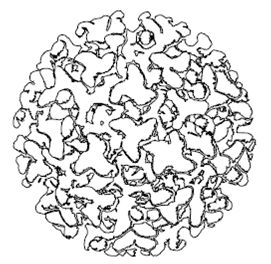Methods of study
While the electron microscope (EM) had been known for several years, the development of the negative-staining technique in 1959 revolutionized studies on virus structure. In negative-contrast EM virus particles are mixed with a heavy metal solution and dried onto a support film. A metal ion does not (ideally) interact with virions but instead provide an electron-opaque background against which the virus can be visualized. Compounds such as uranyl acetate, sodium silicotungstate, and methylamine tungstate are especially good for viruses due to the high-resolution images they can produce. Observation underthe EM has thus allowed the definition of virus morphology at the 20–50Å resolution level. Additionally, negative staining of thin sections of infected cells has allowed definition of structures that appear during virus maturation and their interactions with cellular proteins. Newer developments include the use of immunoelectron microscopy, where the binding of antibodies labeled with gold particles allows viruses at low concentration, or which grow poorly in tissue culture, to be identified more readily. Electron cryomicroscopy reduces the risk of artifacts that may be unavoidable when using negative staining. High concentrations of virus are repeated frozen in liquid ethane while on carbon grids.
The Electron micrographs can be digitized, allowing 3-dimensional reconstructions to be predicted – resolutions of 9Å have been achieved using this method. Atomic force microscopy (AFM) allows direct imaging of the three-dimensional morphology of viruses, and where used to date it has confirmed the predictions from digitized EM images. X-ray diffraction of virus crystals is the ultimate approach in determining the ultrastructure of virion morphology. At current, only simple viruses can be crystallized more complex viruses are analyzed through attempting to form crystals of sub exacting molecules. The X-ray diffraction pattern of the virion particle allows mathematical processing that can predict the molecular configuration of the virus particle.

Figure: Three-dimensional reconstruction of an icosahedrally symmetric virus particle.